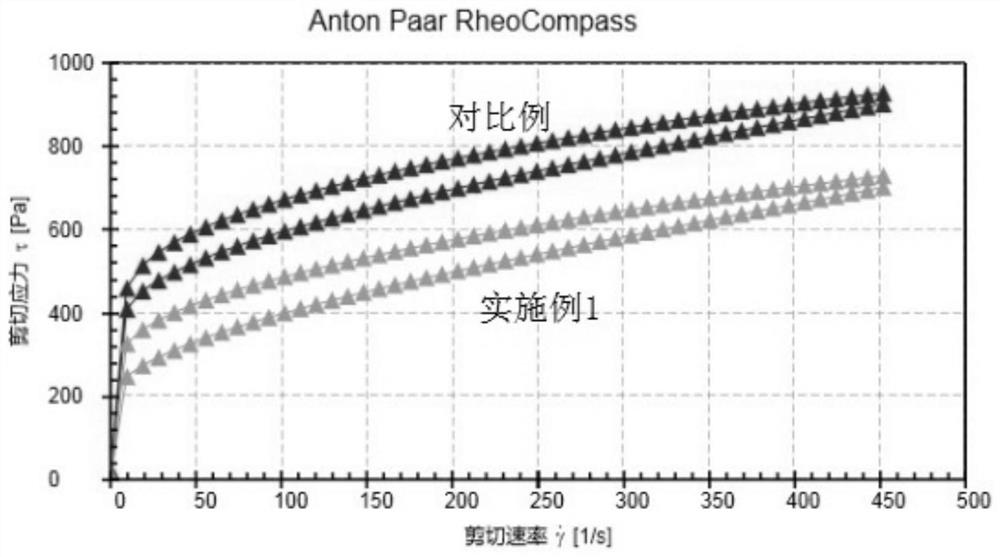Surface treatment method of nano calcium carbonate for impact-resistant automobile chassis coating
A technology of nano-calcium carbonate and automobile chassis, applied in inorganic pigment treatment, calcium carbonate/strontium/barium, nanotechnology for materials and surface science, etc., can solve the problem of low impact resistance and moisture absorption, which affects the appearance of automobile chassis and other problems to achieve the effects of regular crystal morphology, improved stability, and stable nucleation rate
- Summary
- Abstract
- Description
- Claims
- Application Information
AI Technical Summary
Problems solved by technology
Method used
Image
Examples
Embodiment 1
[0035] A surface treatment method of nano-calcium carbonate for impact-resistant automobile chassis coatings, comprising the steps of:
[0036] S1: Dilute milk of lime to obtain a slurry, adjust the specific gravity to 1.060, control the temperature at 23°C, and place the slurry in a carbonization tower for carbonation;
[0037] S2: Introducing CO into the slurry 2 , to regulate CO 2 The concentration is 33%, the volume flow rate is 2.0m 3 / h carry out carbonation reaction, measure electrical conductivity by instrument and add calcium carbonate quality to be 1.5% crystal formation control agent at the lowest point of gelation conductivity at the initial stage of carbonization, and described crystal formation control agent is 3:2:5 by mass ratio Composed of sucrose, sodium polyacrylate and barium chloride, stirred and reacted until PH≤7 to obtain calcium carbonate suspension;
[0038] S3: The calcium carbonate suspension is heated to 75°C for lipophilic surface treatment, stir...
Embodiment 2
[0041] A surface treatment method of nano-calcium carbonate for impact-resistant automobile chassis coatings, comprising the steps of:
[0042] S1: Dilute milk of lime to obtain a slurry, adjust the specific gravity to 1.050, control the temperature to 20°C, and place the slurry in a carbonization tower for carbonation;
[0043] S2: Introducing CO into the slurry 2 , to regulate CO 2 The concentration is 30%, the volume flow rate is 1.5m3 / h to carry out the carbonation reaction, the conductivity is measured by the instrument and the crystal form control agent is added at the lowest point of the gelation conductivity in the early stage of carbonization, and the mass ratio of the crystal form control agent is 2: 1:3 composition of sucrose, sodium polyacrylate and magnesium chloride, stirred and reacted until PH≤7 to obtain calcium carbonate suspension;
[0044] S3: The calcium carbonate suspension is warmed up to 75°C for lipophilic surface treatment, stirred and added with so...
Embodiment 3
[0047] A surface treatment method of nano-calcium carbonate for impact-resistant automobile chassis coatings, comprising the steps of:
[0048] S1: Dilute milk of lime to obtain slurry, adjust the specific gravity to 1.070, control the temperature at 25°C, and place the slurry in a carbonization tower for carbonation;
[0049] S2: Introducing CO into the slurry 2 , to regulate CO 2 The concentration is 33%, the volume flow rate is 2.0m 3 / h carries out the carbonation reaction, measures electrical conductivity by instrument and adds the crystal formation control agent that calcium carbonate dry basis weight is 1.7% at the lowest point of carbonization initial stage gelling conductivity, and described crystal formation control agent is 2:3 by mass ratio : 5 sucrose, sodium polyacrylate and magnesium chloride form, stirring reaction until PH≤7, obtain calcium carbonate suspension;
[0050] S3: The calcium carbonate suspension is heated to 80°C for lipophilic surface treatment...
PUM
 Login to View More
Login to View More Abstract
Description
Claims
Application Information
 Login to View More
Login to View More - R&D
- Intellectual Property
- Life Sciences
- Materials
- Tech Scout
- Unparalleled Data Quality
- Higher Quality Content
- 60% Fewer Hallucinations
Browse by: Latest US Patents, China's latest patents, Technical Efficacy Thesaurus, Application Domain, Technology Topic, Popular Technical Reports.
© 2025 PatSnap. All rights reserved.Legal|Privacy policy|Modern Slavery Act Transparency Statement|Sitemap|About US| Contact US: help@patsnap.com



